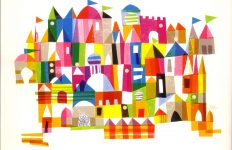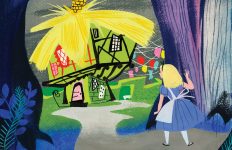Mary Blair died in 1978, shortly after I was born, and I didn’t know who she was for many years after that. But my life was steeped in her in a way I didn’t realize. For one, I remember having a picture book of Cinderella that was, looking back on it, very clearly illustrated by her. For another thing, I spent quite a lot of my life between those two great murals in Tomorrowland or on It’s a Small World or in some other space influenced by her work. Where there is Disney, at least of a certain era, there is Mary Blair.
Goodness knows there’s more to Mary Blair than her work with Disney, but the work with Disney is what lingers. How can it not? You could argue that It’s a Small World is literally a monument to her art; the only people whose touch is as noticeable there is the Sherman Brothers, whom we’ll surely get to another time. (Note, I capitalize the ride’s name even though official Disney syntax has it lowercase, because that’s terrible.) But even without that ride, much mid-century Disney has Mary Blair’s stamp on it, either directly or indirectly. Once you know her artistic style, it’s everywhere.
Animation was not and is not the most egalitarian field. Blair received a posthumous Winsor McKay Award in 1996, making her one of six women (by my count; I may have missed one or two) so honoured since 1972. Most years, three people are selected for the award. Two of them have been women who aren’t voice actors. The Disney Legends awards are somewhat more egalitarian, but even there, more women are awarded in performing categories than behind-the-scenes. Like, am I glad Carrie Fisher was inducted this year? I am. But the four Golden Girls were inducted in 2009, and I had to look up why when I was writing about Betty White a few months ago.
She may, however, have been one of the first animators I ever saw, as she appears as herself in Saludos Amigos. Which we’ll also get to. But there’s a sequence in it wherein various animators talk about what they see and what they choose to draw, and she’s included. As I’ve said before, no one would ever mistake the Walt Disney Studios of that era for a feminist paradise, goodness knows, but she was one of the animators shown, and the film is infused with her artistic style even when she’s not onscreen. Had I been a little girl interested in going into animation—it rather helps to be good at drawing, if that’s your interest—I might have been inspired by her appearance there.
Really, even though this is for my Disney column, I wish I could talk more about her non-Disney work. I’m just not hugely familiar with it. I suppose if I were more of an art person, that would be different, but Mary Blair is an artist completely intertwined with her Disney work so far as most people are concerned. She did enormous pieces, and it’s depressing that I’m pretty sure at least one of the ones in Disneyland, and probably both, were destroyed rather than disassembled and stored. It’s heartrending and wasteful—especially since one of the murals was replaced with theme art for a ride that was gone almost immediately.
Honestly, I could use her to start teaching my kids about artistic style. Hers is bold and specific; you will never mistake Mary Blair’s work for anyone else’s, once you know how to recognize it. Here are a few examples of that work, just in case you’re in doubt.
Support my art; consider subscribing to my Patreon!





